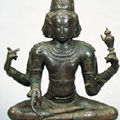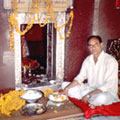|
|
 |
 |
| Consecration of the Image |
|
|
The image is often described in medieval South Asian texts as the body or embodiment of the life force of the deity, in the same way that human bodies are enlivened by the presence of the human soul. The deity is actually present within the image, considered by many to be a form of God himself or herself. This is only possible when the deity allows it to occur. For images that are self-originating (swayambhu) and not human-made, the intervention of human intention is not required in the establishment of divine presence. Human intervention is required for manufactured images, to make them suitable as the abode of God.
The general term for the enlivening of an image is the "establishment of breath" (pranapratistha) or "establishment" (sthapana). This is not a single event, but a process through which the deity becomes fully present in the image. The process consists of a series of rituals, integrated with the actual making of the image and the beginning of its ritual life in a temple or shrine. The opening of the eyes constitutes a central event in the coming into being of the divinely infused image (Figure 1). This step prepares the image to engage fully with devotees in visual interaction (darshan, or "sight"), although eyes are not required to make dynamic and mutual visual exchange possible. The creation of eyes is most obviously related to the making of anthropomorphic images, but non-anthropomorphic (aniconic) images may have eyes as well. Eyes or eye-like shapes are often added to aniconic forms to facilitate visual interaction between deity and devotee. This visual interaction is a key element of Hindu worship (puja), and is a primary means of interaction between deity and devotee, through a mutual visual exchange (Figure 2).
Consecration can also be seen as a way to define the meaning of a devotional image, and a way to define who has the authority to determine that meaning. Many people are involved in the process of consecration, and participants can represent many different caste and class backgrounds. Artists and craftspeople, for example, play important roles in consecration. Brahmin priests can also be important, though at times their involvement seems to focus only on particular aspects of the process, such as the ritual opening of the eyes, and can be quite limited.
The insertion of Brahmin priests into the process of the consecration of images can represent the imposition of brahminical practices onto what was previously a tribal or folk practice among lower castes. For example, in Orissa, wooden poles are used to represent a variety of different deities (most notably the three central images in the Jagannath temple in Puri). Lower-caste priests are responsible for the creation and consecration of the poles, except in the final stages, when Brahmin priests perform the culminating rites. In addition, it is common now to see aniconic, self-born central images accompanied by anthropomorphic festival images that are created and consecrated according to brahminical norms. Consecration processes, therefore, can reflect complex social and historical relationships, as disparate traditions come to be associated and practices from different social spheres interact. The great traditions of Hinduism have been born and reborn in this dynamic interaction.
< previous next >
Top |
|
 |
 |
| Click for details |
 |
 |
 |
Fig. 1
|
 |
 |
 |
Fig. 2
|
 |
|
 |


